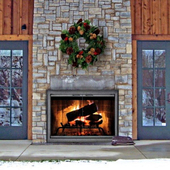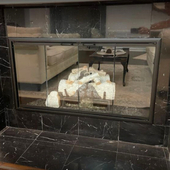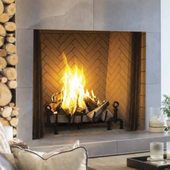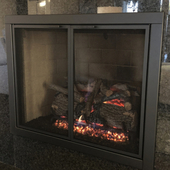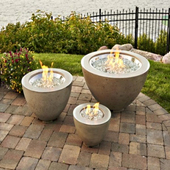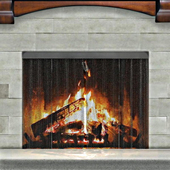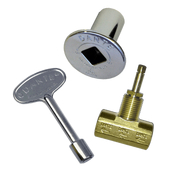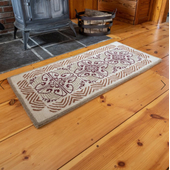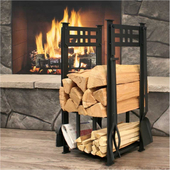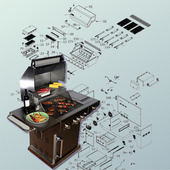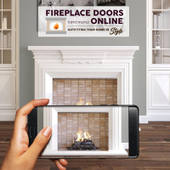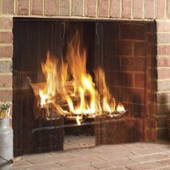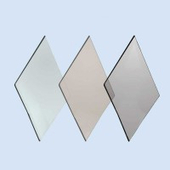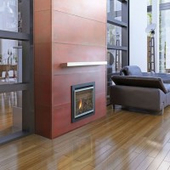Gas fireplaces come in three main styles: Direct Vent, Ventless (Vent-Free), and B-Vent. Each style offers distinct advantages, making it essential to understand their workings, venting requirements, ideal locations, and popular models before making a purchase.
Direct Vent Fireplaces: Efficient and Safe
Direct Vent fireplaces stand out as the most popular and efficient choice among gas fireplace styles. These fireplaces provide a safe alternative to traditional wood and gas-burning options. Unlike traditional fireplaces, they don't need a brick chimney.
How They Work: Direct Vent fireplaces utilize a sealed venting system, bringing fresh outside air into the firebox for combustion while simultaneously expelling combustion gases outside the home. This process maintains indoor air quality, prevents the drawing of air from inside the home for combustion, and ensures that combustion byproducts, like carbon monoxide, cannot re-enter the living space.
Venting Options: Direct Vent fireplaces employ either a co-linear or co-axial venting system.
Co-Linear Venting: This system features two pipes running parallel to each other. One pipe pulls in fresh air for combustion, while the other exhausts combustion byproducts. Co-linear venting is commonly used with Direct Vent inserts in masonry chimneys and typically terminates vertically.
Co-Axial Venting: Comprising a pipe within a pipe, co-axial systems maintain a separation of one inch or more between the two. The outer pipe draws in fresh outside air for combustion, while the inner pipe expels combustion byproducts. This configuration creates a convection loop, ensuring a consistent flow of heat as hot air exits the home, pulling in cool air from outdoors.
Understanding the benefits and workings of Direct Vent fireplaces is crucial when considering a gas fireplace for your home. Stay informed to make a well-informed decision that aligns with your needs and preferences.
In the realm of gas fireplaces, the heat circulation process is integral to maximizing warmth and comfort within your home. Understanding the mechanisms involved in distributing heat, venting requirements, and suitable installation locations is key to optimizing the benefits of a Direct Vent fireplace.
Heat Circulation:
Within the home, the convection air intake on the lower section of the firebox pulls in cool air. This air circulates around the firebox, absorbing the warmth, and is then released back into the room as heated air. Some models offer an optional blower, known as a fan, to facilitate the dissemination of hot air into the room. For enhanced heat distribution, certain fireplaces can incorporate a heat dump system, transferring excess heat to another room.
Utilizing a heat dump system not only improves heat distribution but also reduces clearance requirements above the fireplace. Some manufacturers even permit the overhead mounting of a TV with these reduced clearances. Typically found in higher-end fireplaces with increased heat outputs, heat dump systems are designed to enhance efficiency and comfort.
The firebox of a Direct Vent fireplace features a sealed glass front and a safety barrier screen. This design ensures the fireplace's efficient operation while preventing harmful byproducts from entering the home. Standard models use tempered glass, with ceramic glass available as an upgrade. The safety barrier screen serves to safeguard against direct contact with the heat-emitting glass.
Venting Requirements:
Venting options for Direct Vent fireplaces include co-axial venting and co-linear venting. Co-axial venting involves flexible or rigid, double-walled pipes, while co-linear venting requires two continuous flexible pipes, primarily for Direct Vent inserts.
Flue outlets on the top or rear of the firebox allow for versatile venting configurations. Whether terminated vertically or horizontally, as long as the vent run meets the manufacturer's specifications, both options are viable. Proprietary venting systems are sometimes manufacturer-specific, necessitating compliance with the chosen gas fireplace's requirements.
Installation Locations:
With diverse venting options, Direct Vent fireplaces can be installed in various locations, including bedrooms, basements, and bathrooms. Local building and fire codes vary, so checking specific requirements for your city and state is crucial before installation.
Safety Assurance:
When professionally installed, Direct Vent fireplaces are deemed safe. Their sealed design, utilizing outside air for combustion, ensures no combustion byproducts enter the indoor air. Regular servicing by a licensed professional is recommended for cleaning and burner calibration. Carbon monoxide detectors are a prudent addition to ensure ongoing safety.
It is imperative not to operate the fireplace without the safety barrier or glass front in place, as the removal of the glass front can disrupt proper functioning, potentially allowing combustion gases to enter the home.
Styles Available:
Direct Vent fireplaces come in various styles, catering to diverse preferences. These include linear, traditional, single-sided, multi-sided (peninsula), see-through, and corner styles. Among these, linear models have gained significant popularity due to their sleek design and modern appeal.
Comprehending the intricacies of heat circulation, venting, safety considerations, and available styles is crucial when considering a Direct Vent gas fireplace for your home. Make informed decisions to create a warm, safe, and aesthetically pleasing living space.
Ventless Gas Fireplaces:
Ventless gas fireplaces, also known as Vent-Free fireplaces, offer a unique heating solution by eliminating the need for a chimney or any venting system. This article delves into the workings of Ventless fireplaces, their efficiency, potential considerations, and safety measures.
Understanding Ventless Fireplaces:
Ventless gas fireplaces are standalone heating units renowned for their efficient and economical operation. Unlike traditional fireplaces, they don't rely on a chimney for heat dissipation. Instead, all the heat generated by the burner remains within the home, making Ventless fireplaces exceptional heating sources.
While their heat output is substantial, it's important to note that the flame display may appear less intense compared to Direct Vent and B-Vent units. Consequently, Ventless fireplaces are primarily marketed as heaters rather than purely decorative gas appliances.
Operational Mechanism:
Ventless gas fireplaces operate on a closed-loop system utilizing indoor air. Room air is drawn into the firebox for combustion, circulating around the firebox before releasing back into the room as heat. Engineered for nearly 100% efficiency, Ventless fireplaces produce minimal post-combustion gases, consisting mainly of water vapor and carbon dioxide. Dangerous gases, such as carbon monoxide, remain within safe limits.
As these fireplaces consume oxygen during combustion, they release moisture in the form of water vapor. This can lead to condensation, especially with liquid propane gas. While a small amount of moisture can be beneficial in dry winter months, excessive moisture might contribute to mildew or mold growth. Opening a window or using a hygrometer to monitor humidity levels can help maintain a balanced environment.
To ensure normal oxygen and humidity levels, it's generally recommended to operate a Ventless fireplace for a maximum of one hour at a time and four hours in a single day.
While safety barrier screens are not legally mandated for Ventless fireplaces, some models come equipped with them as a popular addition for enhanced safety, providing protection from the fire.
No Venting Required:
One of the distinctive features of Ventless gas fireplaces is their freedom from any venting requirements. This eliminates the need for a chimney, making them versatile and easy to install in various locations within your home.
In conclusion, Ventless gas fireplaces offer efficient heating solutions without the constraints of venting systems. Understanding their operational mechanisms, efficiency considerations, and safety measures empowers homeowners to make informed decisions about incorporating Ventless fireplaces into their living spaces.
Choosing the Right Location for Your Ventless Fireplace: Installation Considerations
Ventless fireplaces offer unparalleled flexibility in installation, presenting a versatile heating option without the need for a chimney. However, several factors, including room size, media bed modifications, elevation, and location restrictions, should be carefully considered.
Installation Considerations:
Room Size and Ventilation:
- Ventless fireplaces, lacking a chimney or venting, raise concerns about air quality and oxygen depletion.
- Unsuitable for small or confined rooms with limited oxygen supply.
- Ensure proper room ventilation to prevent potential issues with oxygen levels.
Gas Logs Installation:
- Gas logs, if chosen for the media bed, must adhere strictly to the manufacturer's specifications.
- Modifications to the arrangement are prohibited to prevent flame impingement and the production of toxic gases.
- Flame impingement occurs when flames touch the logs, and without venting, harmful byproducts enter the living space.
Air to Gas Ratio and Calibration:
- Ventless gas fireplaces are calibrated by the manufacturer to maintain a specific air-to-gas ratio.
- This ensures minimal byproducts after combustion, emphasizing safety and efficiency.
High Elevation Adjustments:
- In areas with higher elevations, such as Colorado, adjustments to the gas output may be necessary due to thinner air quality.
- Manufacturers or licensed gas professionals can make these adjustments during purchase or installation.
Safety Considerations:
Controversies and Legal Restrictions:
- While considered safe, Ventless fireplaces face controversies, leading to legal restrictions in some states like California.
- Research local building, city, and state codes for installation restrictions and minimum room size requirements.
Oxygen Depletion Sensor (ODS):
- Vent-Free appliances are mandated to have an Oxygen Depletion Sensor (ODS) on the ignition pilot.
- The ODS monitors oxygen levels, shutting off the gas supply if levels fall below the safe threshold (18%).
BTU Output Limitations:
- Maximum BTU output for Ventless gas fireplaces is capped at 40,000 BTUs per hour to maintain adequate oxygen levels.
- Bathroom and bedroom installations have even more restricted BTU outputs (6,000 to 10,000 BTUs), regardless of room size.
Odor Intensification:
- As combustion air can't escape through a chimney, Ventless fireplaces intensify existing odors within the home.
- Presence of air fresheners, incense, perfume, dust, or pet dander strongly influences the fireplace's odor.
Respiratory Health Considerations:
- Exhaust from Ventless fireplaces can irritate the lungs, making them unsuitable for households with sensitive individuals or respiratory issues.
Available Styles:
Ventless gas fireplaces are available in various styles, mirroring Direct Vent options, with linear designs being particularly popular.
While Ventless fireplaces offer installation flexibility, thorough consideration of safety measures, legal restrictions, and room-specific factors is essential to ensure their optimal and safe operation within your living space.
Understanding B-Vent Gas Fireplaces
B-Vent gas fireplaces, often referred to as Natural Vent, constitute a less popular choice among gas fireplace options. While they offer affordability, their efficiency and installation flexibility are limited compared to Direct Vent and Ventless counterparts.
Operation of B-Vent Fireplaces:
Open-Front Design:
- B-Vent fireplaces feature an open-front design, resembling the operation of traditional wood-burning fireplaces.
Combustion Process:
- Combustion occurs by pulling fresh air from inside the home into the firebox.
- A vertical pipe is employed to carry away exhaust and combustion fumes.
Heat Efficiency:
- Most of the heat generated escapes through the venting, resulting in lower efficiency.
- Primarily used for aesthetic appeal rather than serving as a significant heat source.
Venting Requirements:
Double-Walled, Insulated Pipe:
- B-Vent fireplaces utilize a double-walled, insulated pipe for venting.
- The space between inner and outer pipes provides insulation, preventing heat loss and facilitating efficient exhaust.
Affordability and Ease of Installation:
- B-Vent pipe is cost-effective and relatively easy to install.
- Its installation, however, requires a vertical run through the home, terminating above the roof.
Installation Considerations:
Vertical Termination:
- Similar to a masonry chimney, B-Vent fireplaces necessitate vertical termination through the roof.
- Installation is limited to areas accommodating a straight vertical pipe run to the roof.
Safety Assurance:
Venting for Combustion Byproducts:
- B-Vent fireplaces maintain safety by employing vertical venting to expel combustion byproducts.
- This prevents the accumulation of dangerous gases within the home.
Downdraft Sensor:
- Some B-Vent fireplaces feature a sensor capable of shutting off the unit in the event of a downdraft.
- This safety feature prevents exhaust from being forced back down the chimney into the home.
Available Styles:
- Inserts and Customizable Masonry Fireboxes:
- B-Vent fireplaces are available as inserts and customizable masonry fireboxes.
Customizable fireboxes allow homeowners to match the finish with their home's décor, offering versatility in achieving a contemporary or traditional look.
While B-Vent gas fireplaces may lack the efficiency and installation flexibility of other options, they serve as a budget-friendly choice, particularly appreciated for their aesthetic appeal. Understanding their operational characteristics, venting requirements, and safety features ensures a well-informed decision when considering B-Vent fireplaces for your home.
Understanding Gas Fireplace Ignition Systems: A Comprehensive Guide
Gas fireplaces come equipped with two primary ignition systems: intermittent pilot ignition (IPI) and continuous pilot ignition (CPI). These systems dictate how the pilot flame is initiated, maintained, and the subsequent fuel supply to the burner. Both IPI and CPI systems offer distinct advantages, and choosing the right one depends on factors such as climate, frequency of use, and personal preferences.
1. Intermittent Pilot Ignition (IPI):
Pilot Activation:
- The pilot is ignited initially using a switch on the fireplace.
Flame-Sensing Thermocouple:
- After establishing the flame, a flame-sensing thermocouple detects the heat and generates an electrical current to the gas valve.
Continuous Operation:
- The gas valve remains open, providing a constant fuel stream to the pilot light.
Shutdown Mechanism:
- If the flame extinguishes, the cooling thermocouple interrupts the electrical current, shutting off the gas supply.
Best For:
- IPI systems are suitable for warm climates or occasional fireplace use, as the pilot extinguishes when the fireplace is turned off.
Energy Saving Note:
- IPI systems conserve gas, but the startup duration is longer (15-20 seconds) each time the fireplace is activated.
2. Continuous Pilot Ignition (CPI):
Persistent Pilot Flame:
- The pilot flame is continually maintained unless there is a gas supply issue.
Climate Suitability:
- Ideal for cold climates or areas with prolonged winters where frequent fireplace use is anticipated.
Enhanced Start-up:
- The consistent pilot flame keeps the firebox and flue warmer, facilitating a smoother start-up process.
Backup During Power Outage:
- Most gas fireplaces include a battery backup to enable ignition during power outages.
Consideration:
- Features reliant on electricity, such as lights and blowers, won't function during a power outage.
Choosing the Right System:
Climate Considerations:
- IPI suits warm climates with sporadic fireplace use, while CPI is preferable for colder regions with frequent fireplace utilization.
Startup Preferences:
- Consider the startup time and frequency of fireplace use when selecting between IPI and CPI.
Power Outage Preparedness:
- Assess the importance of features requiring electricity during power outages.
Understanding the distinctions between intermittent pilot ignition and continuous pilot ignition empowers homeowners to make informed decisions based on their specific needs and preferences. Whether prioritizing energy efficiency, climate suitability, or startup convenience, selecting the right ignition system enhances the overall gas
Mastering Gas Fireplace Controls: A User-Friendly Guide
Gas fireplaces have evolved beyond mere warmth providers, now offering sophisticated controls that enhance user convenience and customization. Understanding the available control options empowers users to create the perfect ambiance, manage heat output, and seamlessly integrate their fireplace into modern smart home systems.
1. Hand-Held Remote Control:
Basic Functionality:
- Standard with most gas fireplaces.
- Enables simple on/off control.
- Convenient for users who prioritize fundamental fireplace operation.
- Enhanced Features:
- Some remotes offer advanced features such as flame height adjustment.
- Useful for those seeking a bit more customization.
2. Wall Switch:
Simplified Operation:
- Acts as an alternative to the remote control.
- Allows users to turn the fireplace on or off with ease.
3. Full-Feature Remotes:
Comprehensive Control:
- Ideal for users desiring a more hands-on experience.
- Controls various aspects, including ignition, blower, lighting, heat output, flame height, thermostat, and timer.
Customization:
- Adjust flame height, heat intensity, and other parameters with precision.
- Provides a tailored fireplace experience.
4. Smart Home Integration:
Next-Level Connectivity:
- Some gas fireplaces can be seamlessly integrated into smart home systems.
- Control the fireplace using a wall-mounted touch screen panel or a dedicated smartphone app.
Remote Access:
- Allows users to operate the fireplace remotely, enhancing flexibility.
- Integration with voice-activated virtual assistants adds a layer of futuristic convenience.
Choosing the Right Control:
User Preferences:
- Consider whether basic on/off control suffices or if advanced customization is desired.
Integration Needs:
- Assess whether integrating the fireplace into a smart home system aligns with your preferences.
Convenience vs. Complexity:
- Balance the desire for sophisticated features with ease of use.
Maintenance and Troubleshooting:
- Battery Replacement:
- Keep spare batteries for remotes to avoid interruptions.
Regular Checks:
- Periodically inspect controls to ensure proper functionality.
Gas fireplace controls have transitioned from basic on/off switches to sophisticated systems offering unparalleled customization. Whether opting for the simplicity of a remote or embracing the futuristic integration with smart home systems, users can tailor their gas fireplace experience to match their unique preferences and lifestyle.












